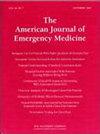Adult skateboarding and motorized board injuries: A comparative analysis
IF 2.7
3区 医学
Q1 EMERGENCY MEDICINE
引用次数: 0
Abstract
Objectives
Skateboarding and motorized boards are popular as a recreational activity and mode of transportation. Prior studies have investigated injury patterns from these activities in the pediatric population, but there is little data in the adult population. This study aims to investigate and compare the type and severity of injuries associated with skateboarding and motorized boards.
Methods
Retrospective analysis of injury data collected from the NIESS (National Electronic Injury Surveillance system) database, including cases of fractures involving skateboards or motorized boards from 2018 to 2022. Data collected was demographic information, injury characteristics (e.g., body region affected, injury type), environmental factors, mechanism of injury, and hospital treatment and disposition. Statistical analysis including chi-square and independent t-test were employed to determine significant differences in injury pattern.
Results
A total of 104,301 cases were included for analysis. 73.0 % of patients were male. 61.8 % of injuries were to the upper extremity. The most common fractures were of the wrist (20.2 %) and ankle (12.4 %). Patients injured on motorized boards were more likely to be older (40.0 ± 15.4 years) than those injured on skateboards (27.8 ± 9.8 years; p < 0.001). 13.9 % of fractures required hospital admission. Skateboard accidents were more likely to present with lower extremity fractures (p < 0.001), despite upper extremity injuries being the majority in both groups. There was a significant association between motorized board injuries and multiple fractures (p < 0.001, OR = 1.2), and hospital admission (p < 0.001, OR = 1.7).
Discussion
Our study shows a high prevalence of upper extremity injuries, regardless of board type. Motorized boards are associated with a higher risk of multiple fractures and hospital admission. Motorized boards likely have increased risk due to their ability to sustain elevated speeds.
成人滑板和机动滑板伤害:比较分析
目的滑板和电动滑板作为一种娱乐活动和交通工具很受欢迎。之前的研究已经调查了这些活动在儿童群体中的伤害模式,但在成人群体中的数据却很少。本研究旨在调查和比较与滑板和电动滑板相关的损伤类型和严重程度。方法回顾性分析从 NIESS(国家电子损伤监测系统)数据库中收集的损伤数据,包括 2018 年至 2022 年涉及滑板或电动滑板的骨折病例。收集的数据包括人口统计学信息、损伤特征(如受影响的身体区域、损伤类型)、环境因素、损伤机制以及医院治疗和处置。统计分析包括卡方检验(chi-square)和独立t检验(independent t-test),以确定损伤模式的显著差异。73.0%的患者为男性。61.8%的损伤发生在上肢。最常见的骨折部位是手腕(20.2%)和脚踝(12.4%)。在机动板上受伤的患者年龄(40.0 ± 15.4 岁)高于在滑板上受伤的患者(27.8 ± 9.8 岁;P < 0.001)。13.9%的骨折患者需要入院治疗。滑板事故更可能导致下肢骨折(p <0.001),尽管上肢受伤在两组中都占多数。我们的研究表明,无论滑板类型如何,上肢受伤的发生率都很高。电动滑板发生多发性骨折和入院的风险较高。电动滑板能够保持较高的速度,因此其风险可能会增加。
本文章由计算机程序翻译,如有差异,请以英文原文为准。
求助全文
约1分钟内获得全文
求助全文
来源期刊
CiteScore
6.00
自引率
5.60%
发文量
730
审稿时长
42 days
期刊介绍:
A distinctive blend of practicality and scholarliness makes the American Journal of Emergency Medicine a key source for information on emergency medical care. Covering all activities concerned with emergency medicine, it is the journal to turn to for information to help increase the ability to understand, recognize and treat emergency conditions. Issues contain clinical articles, case reports, review articles, editorials, international notes, book reviews and more.

 求助内容:
求助内容: 应助结果提醒方式:
应助结果提醒方式:


